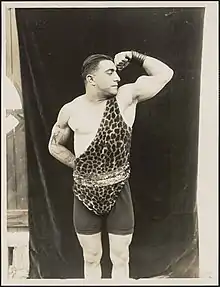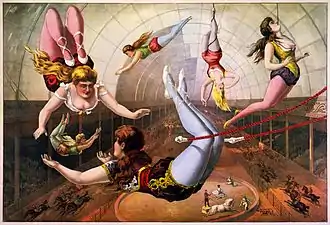Strongman (strength athlete)
In the 19th century, the term strongman referred to an exhibitor of strength or similar circus performers who performed feats of strength. More recently, strength athletics, also known as strongman competitions, have grown in popularity. These competitions are now composed of a variety of events in which competitors have to move the highest weights possible, the winner being the one having the highest tally across all events.[1]


Description

In the past, strongmen would perform various feats of strength such as the bent press (not to be confused with the bench press, which did not exist at the time), supporting large amounts of weight held overhead at arm's length, steel bending, chain breaking, etc. Large amounts of wrist, hand, and tendon strength were required for these feats, as well as prodigious oblique strength.
In the late 20th century the term strongman evolved to describe one who competes in strength athletics – a more modern eclectic strength competition in which competitors display their raw functional strength through exercises such as lifting rocks, toting refrigerators, pulling trains, towing an eighteen-wheel truck behind them, etc. The most famous competitions of this type are the World's Strongest Man, the Arnold Strongman Classic, the Strongman Champions League and the Giants Live tour, however many countries hold national-level competitions.
In recent years, interest in the sport at the grassroots level has skyrocketed, leading to the spontaneous formation of local clubs, loosely affiliated with provincial/state and national associations.
Many sports-specific training facilities have begun to incorporate movements associated with strongman competitions into their general training schemes, albeit with lighter weights used, e.g. tyre flips, sled drags, object loading or carrying, log pressing, farmer's walks and so on.
Training
Training for strongman involves building overall strength in the gym and training with competition implements to gain familiarity. In the gym, it is necessary to train the entire body for strength, especially with variants of the squat, deadlift, and overhead press. Also important is explosive power, developed by weightlifting-style lifts, and cardiovascular conditioning. Grip strength must also be developed.
Although you can do general strength training, at a typical gym, training with a strongman regimen requires equipment not typically found in a gym. Some equipment used in a strongman competition would have to be found custom-made or at a strongman gym. These equipment include Atlas Stone, Log (Log Press), Farmers Walk Bars, Yoke (Yoke Walk), Keg (Keg Toss), a vehicle.
Another part of a strongman's training is its intense diet regime. A top athlete in strongman would need to ingest upwards of 10,000 calories a day.
Events
Though competitive strongman events are ever changing, there are a number of staples that frequently appear on the international stage,[2] including:
- Atlas Stones
- Axle Press
- Car Flip
- Conan's Wheel
- Deadlift
- Deadlift hold
- Duck walk
- Dumbbell Press
- Farmers Walk
- Fingal's Fingers
- Frame Carry
- Hercules hold
- Husafell Stone
- Keg Toss
- Loading Race
- Log Clean and Press
- Power stairs
- Squat
- Tire Flip
- Vehicle pull
- Yoke Carry
- Viking Press
Incorrect usage
Strongman is often incorrectly used to describe a person who does weightlifting or bodybuilding. Due to the circus and entertainment background, nineteenth-century bodybuilders were expected to mingle with the crowd during intermission and perform strength feats like card tearing, nail bending, etc. to demonstrate strength as well as symmetry and size. Also, many strongmen sold photos of themselves nude or near-nude, flexing and posing. Although, what they considered the epitome of male beauty was different from modern ideals – particularly the very low emphasis on chest size, and great emphasis on oblique size, and symmetry as evidenced by photos of Eugen Sandow.
Notable strongmen
Traditional
- Paul Edward Anderson
- Mat Tarzan
- The Great Antonio
- Apollon the Mighty
- William Bankier
- Zishe Breitbart
- Louis Cyr
- Donald Dinnie
- Otto Eberstadt
- Angus Graham
- The Great Gama
- Hermann Görner
- Joe Greenstein
- Georg Hackenschmidt
- Georg Lurich
- Angus MacAskill
- Ivan Poddubniy
- Frank Saldo
- Mark Henry
- Monte Saldo
- Eugen Sandow
- Kodi Ramamurthy Naidu
- Arthur Saxon
- Thomas Topham
- Paul Trappen
- Koca Yusuf
- Alexander Zass
- Stanislaus Zbyszko
- Wladek Zbyszko
Modern strongman athletes
The following competing strongmen have finished in the top three of World's Strongest Man, from 1977 to 2019:
- Jouko Ahola
- Gerrit Badenhorst
- Raimonds Bergmanis
- Geoff Capes
- Dominic Filiou
- Hugo Girard
- John Gamble
- Hafþór Júlíus Björnsson
- Eddie Hall
- Lars Hedlund
- Manfred Hoeberl
- Terry Hollands
- Svend Karlsen
- Bill Kazmaier
- Mateusz Kieliszkowski
- Riku Kiri
- Mikhail Koklyaev
- Vytautas Lalas
- Martins Licis
- Tom Magee
- Magnús Ver Magnússon
- Jesse Marunde
- Ilkka Nummisto
- Dave Ostlund
- Ken Patera
- Phil Pfister
- Don Pope
- Derek Poundstone
- Mariusz Pudzianowski
- Flemming Rasmussen
- Jamie Reeves
- Don Reinhoudt
- Magnus Samuelsson
- Žydrūnas Savickas
- Brian Shaw
- Jón Páll Sigmarsson
- Ted van der Parre
- Gary Taylor
- Henning Thorsen
- Marko Varalahti
- Vasyl Virastyuk
- Janne Virtanen
- Cees de Vreugd
- Sebastian Wenta
- O.D. Wilson
- Ab Wolders
- Simon Wulfse
- Bob Young
Fictional strongmen
- Zampanò in Federico Fellini's 1954 film La Strada, played by Anthony Quinn
- Wolfgang in the 2013 survival game Don't Starve.
See also
References
- "STRONGMAN". ERA-FIT Ltd Bespoke Fitness Systems. Retrieved 2019-09-05.
- "Strongman Events". strongman.org. Retrieved 2012-12-28.
External links
| Wikimedia Commons has media related to Strongmen. |
